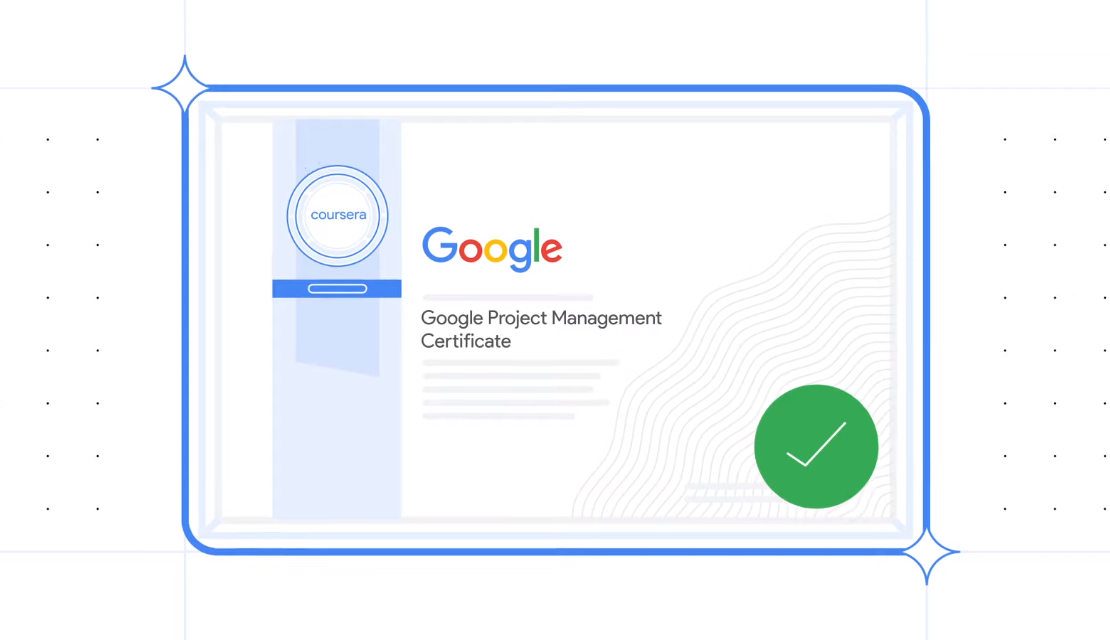As someone who is interested in expanding my knowledge of project management but has no prior experience in the field, the Google project management professional certificate caught my attention. I was drawn to the program because of its complete coverage of all the key aspects of project management, from initiation to closure. The program is tailored to beginners, making it a more accessible option for me. With its comprehensive curriculum and hands-on activities, I felt this professional certificate was an excellent starting point to dive deeper into project management.
What the Google project management certificate is all about
In a nutshell, the Google project management certificate is a comprehensive program designed to equip individuals with the skills, knowledge, and techniques necessary to succeed as a project manager across a variety of industries. The certificate program consists of 6 online courses, each covering different aspects of project management, from foundational concepts to agile methodologies and real-world applications.
The courses are self-paced and designed to be practical, with a mix of interactive video lectures, quizzes, hands-on assignments, and real-world examples to help reinforce the concepts covered. It’s a well-rounded and highly effective way for individuals to gain the knowledge and skills needed to manage projects effectively and advance their careers in project management.
Course 1 – Foundations of Project Management
The first course of the program provided me, as a newcomer to project management, with a valuable introduction to the field. he course starts with a clear definition of what project management is and what constitutes a project, which helped me understand the scope of the role. Additionally, I explored project management roles and responsibilities across a variety of industries, gaining a broader perspective on the field as a whole.
The course also dives into the core skills that are necessary for success as a project manager, which helped me understand the specific abilities I should be working to develop. These skills include, among others, communication, leadership, problem-solving, and time management. I also gained a thorough understanding of the life cycle of a project, learning about the significance of each phase and how they all fit together. Another valuable aspect of this course was the discussion of different program management methodologies and approaches. By comparing these different methods, I was able to start to understand which ones might be most effective for different types of projects.
While I had some prior knowledge about the influence of organizational structure and culture on project management, the section on this topic in the course was truly enlightening. I gained a deeper understanding of how these factors shape project outcomes and learned that a project manager can leverage this knowledge to create a project plan that aligns with the organization’s dynamics, resulting in greater success. Lastly, the course wrapped up with a discussion of change management and the role of the project manager in that process, which was helpful in understanding the broader context of project management within an organization. Change management is a crucial aspect of project management, and by learning how to effectively manage change, a project manager can ensure the success of the project while minimizing risks and disruptions.
Generally speaking, I found this course to be an excellent introduction to project management that provided a solid foundation for the rest of the program.
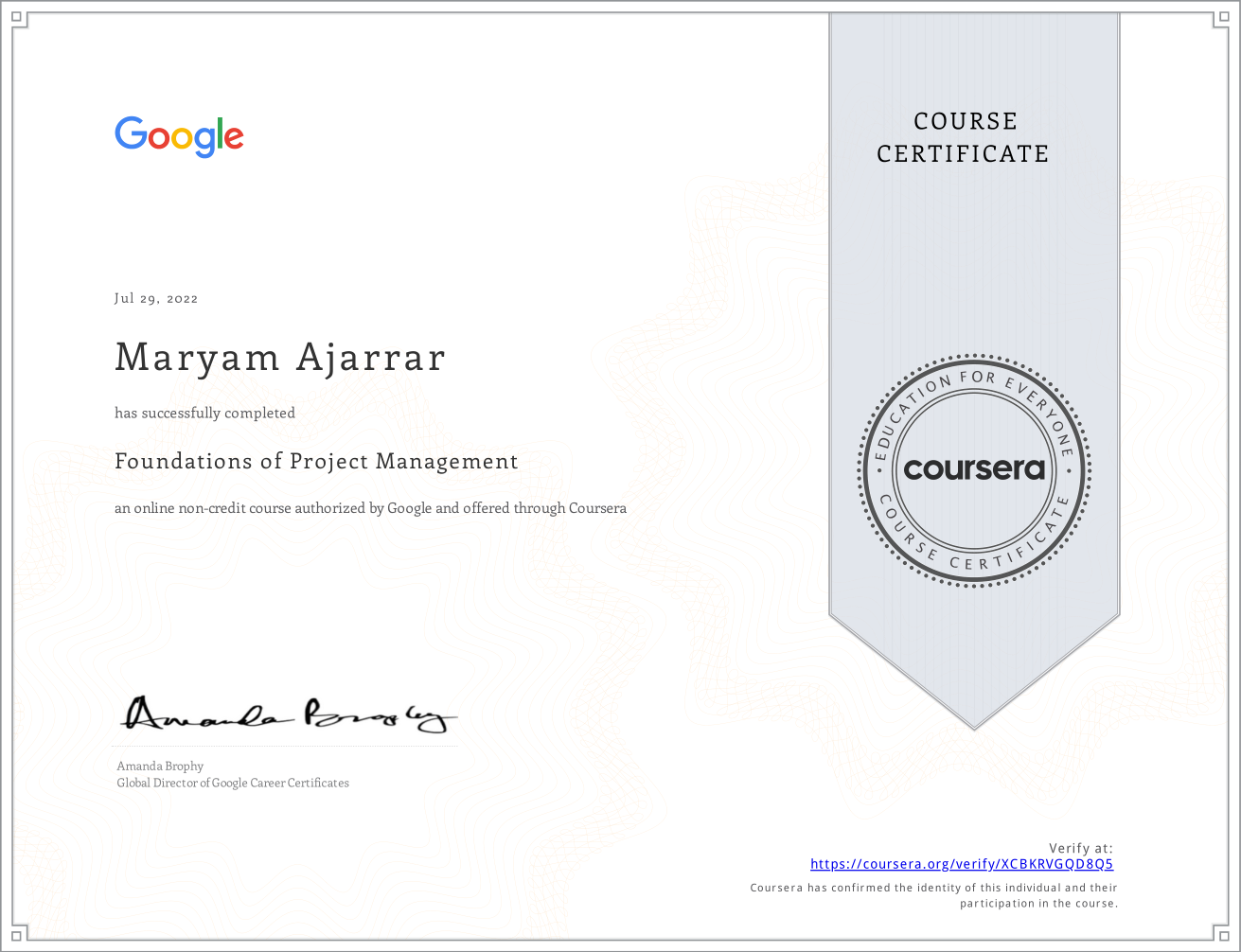
Link to the verified certificate on Coursera
Course 2 – Project Initiation: Starting a Successful Project
The second course in the program provides a comprehensive overview of the project initiation phase of the project life cycle. As someone who is new to project management, I found this course to be extremely helpful in understanding the key components of this initial stage of a project lifecycle. During this course, I learned how to determine a project’s benefits and costs. By understanding these factors, I was better able to evaluate the feasibility of a project and make informed decisions about whether to move forward with it.
The course also covered how to define and create measurable project goals and deliverables, which was helpful in ensuring that everyone on the project team was on the same page about what needed to be accomplished. The section on project scope was also useful, as it helped me understand how to differentiate among tasks that are in-scope and out-of-scope and how to manage scope creep to ensure project goals aren’t impacted. Another valuable part of this course was the discussion of how to define and measure a project’s success criteria. This was helpful in understanding how to evaluate the success of a project once it was completed.
Moreover, the course outlined stakeholder analysis, which is an important component of project initiation phase. By learning how to complete a stakeholder analysis, I was able to figure out how to identify the key players in a project and understand their expectations and needs. Furthermore, I learned how to use a RACI* chart to define and communicate project team members’ responsibilities. Finally, the course covered project charters and the key components that should be included in them, as well as how to develop one for project initiation. This was helpful in understanding how to communicate project goals and deliverables to the rest of the team. Last but not least, I also learned, through this course, how to evaluate various project management tools and resources to meet project needs, which helped me develop a strong understanding of the project initiation phase and how to start a successful project.
RACI is an acronym that stands for Responsible, Accountable, Consulted, and Informed.
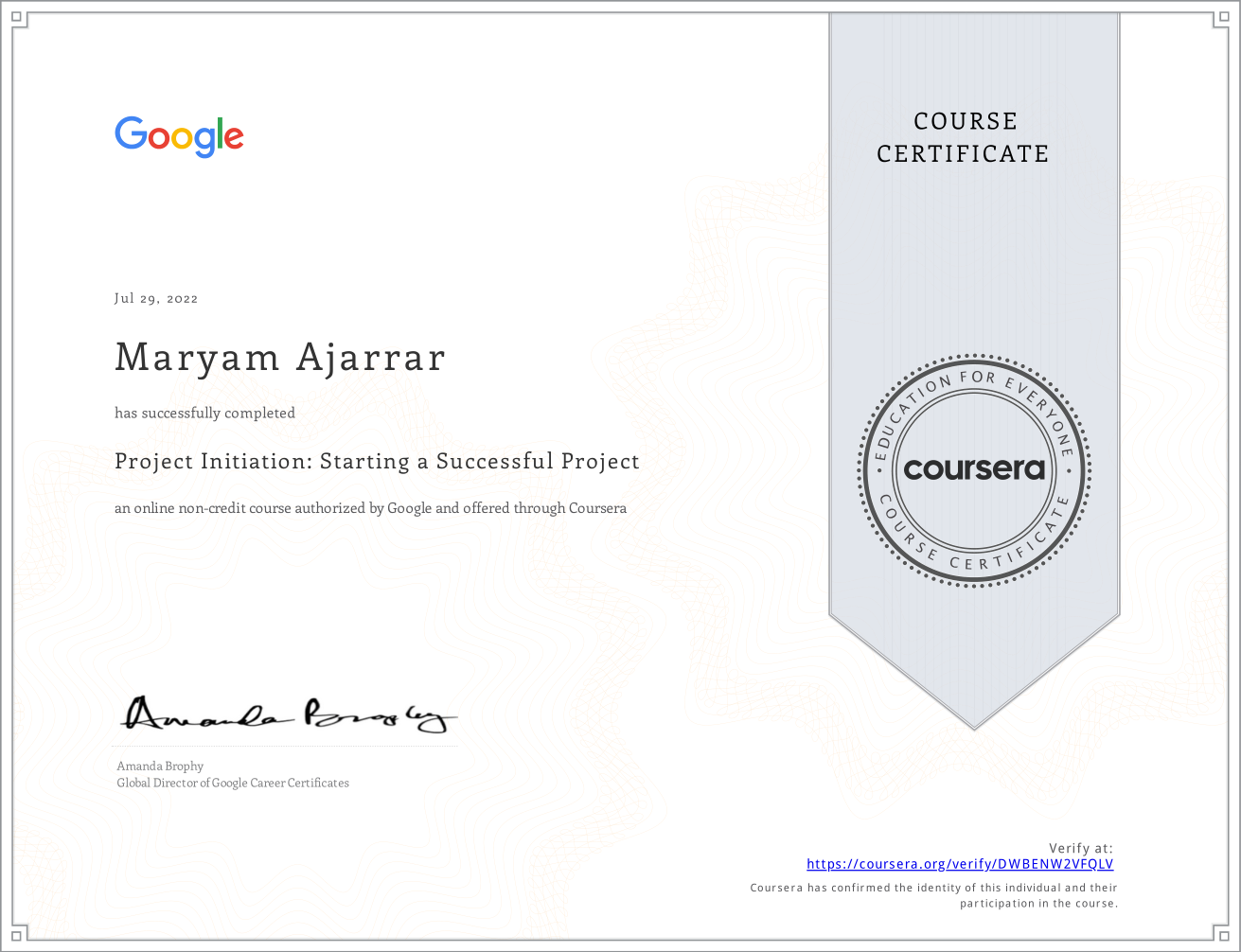
Link to the verified certificate on Coursera
Course 3 – Project Planning: Putting It All Together
This third course builds upon the concepts learned in the previous ones and dives into the second stage of the project life cycle, which is project planning, and its key components in more detail. I found this course to be particularly practical in learning how to build a project plan that is both effective and achievable.
One aspect of the course that I found particularly valuable was the discussion of milestones and their importance in project planning. By learning how to set milestones, I was better able to understand how to track progress and ensure that the project was on track. The course also covered how to make accurate time estimates, which was an essential component of project planning. The techniques for acquiring time estimates from team members were particularly useful, as it helped me understand how to collaborate with the rest of the team to develop a realistic project timeline.
The course also provided a comprehensive overview of the tools and best practices necessary to build a project plan and risk management plan. This was helpful in understanding how to identify potential risks and develop strategies for mitigating them. Another valuable component of the course was the discussion of budgeting and procurement processes. By understanding these processes, I learned how to effectively manage project costs and ensure that the project stayed within budget. Lastly, the course covered communication planning and management, which was an essential component of project planning. By learning how to build a communication plan, I was better able to understand how to ensure that all team members are on the same page and have the information they need to complete their tasks.
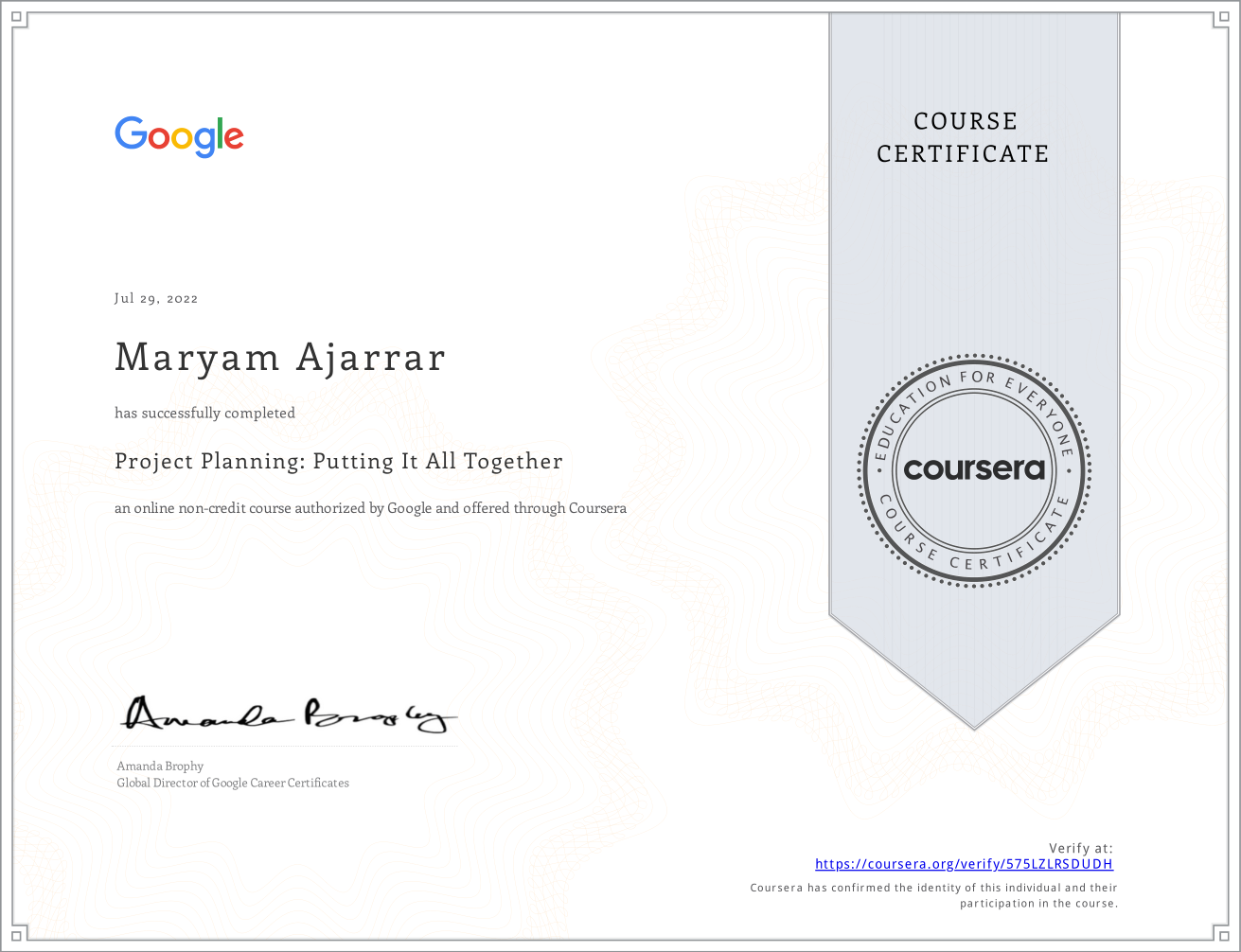
Link to the verified certificate on Coursera
Course 4 – Project Execution: Running the Project
This fourth course of the program was a great continuation of the previous ones, as it provided an in-depth exploration of what it takes to effectively run a project. One aspect of the course that I particularly appreciated was the comparison of different tracking methods, as it helped me better understand what aspects of a project to track and how to choose the best tracking method for a particular project.
Another important aspect that the course addressed was change management, dependencies, and risks, as well as assessing their impact on the project. By understanding how to effectively manage and communicate these elements of a project, I learned how to ensure that the project stayed on track and that any potential issues were addressed in a timely manner. Quality management was also a key focus of the course, with a deep dive into concepts such as quality standards, quality planning, quality assurance, and quality control. This was essential in understanding how to ensure that quality is built into every aspect of a project, from the initial planning stages to the final delivery.
Continuous improvement and process improvement were also emphasized in the course, and I learned how to measure customer satisfaction and use feedback to drive project improvements. I also learned about the importance of retrospectives and how to conduct one to evaluate a project’s successes and areas for improvement. Besides, the importance of data analysis and communication in project execution was also covered in this course. I learned how to prioritize and analyze project data and how to use it to communicate a data-informed story to stakeholders and team members. Additionally, I explored tools that provide effective project team communication and best practices for communicating project status updates.
Finally, the course covered the closing process for stakeholders, the project team, and project managers. I learned about the importance of project documentation, conducting a final project review, and evaluating the project’s success against its initial goals. This was helpful in understanding how to wrap up a project in a way that met everyone’s needs and ensured that all aspects of the project were completed in a satisfactory manner. All in all, the course provided me with a strong understanding of of what it takes to effectively execute a project and deliver successful outcomes.
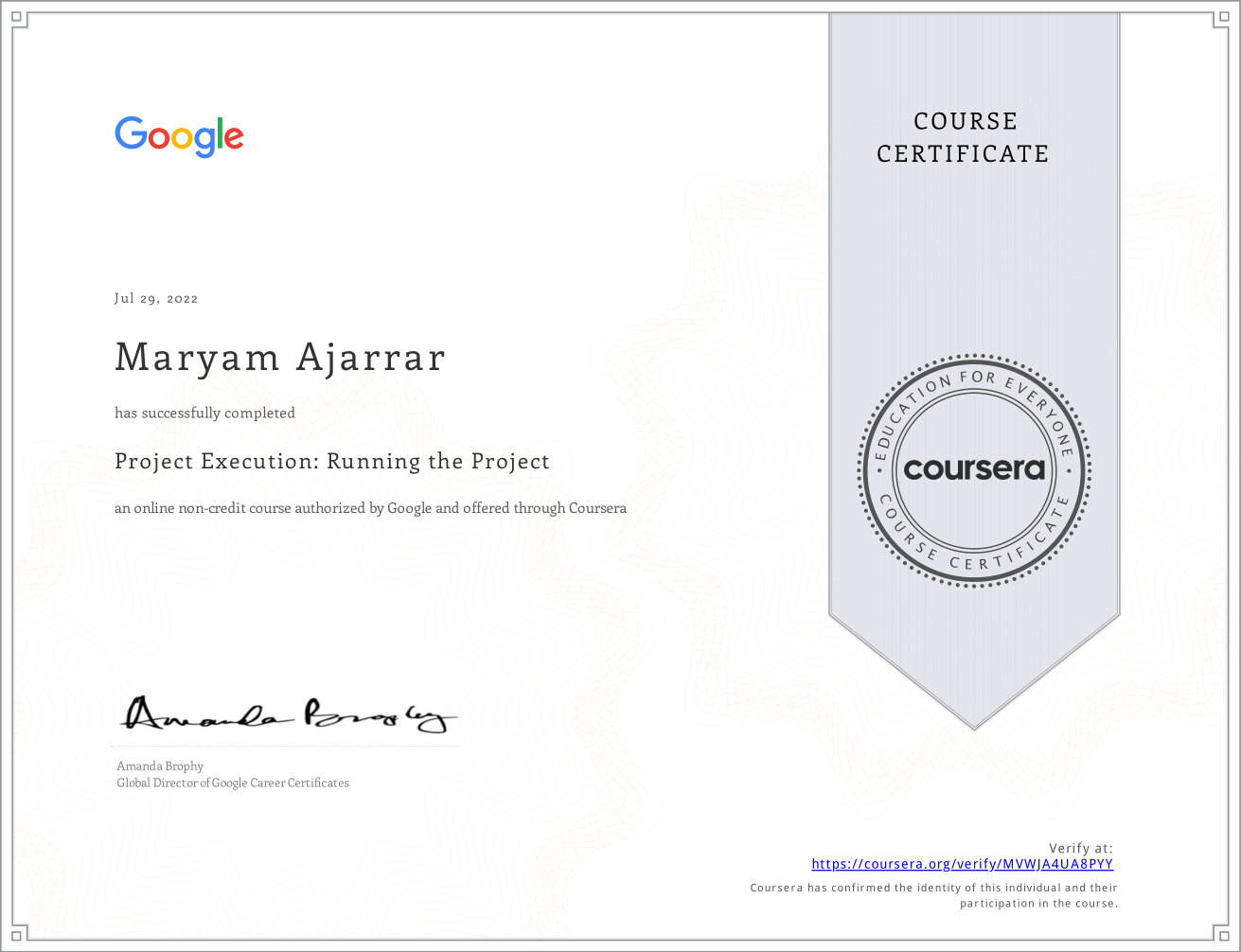
Link to the verified certificate on Coursera
Course 5 – Agile Project Management
This fifth course on Agile project management was a fascinating exploration of a different approach to project management that is becoming increasingly popular in today’s fast-paced business environment. The course started with an explanation of the Agile project management approach and philosophy, including values and principles. This helped me understand the key differences between traditional project management and Agile project management.
The course then went into detail about Scrum, one of the most popular frameworks for Agile project management. I found the discussion of the 3 pillars of Scrum—which are transparency, inspection, and adaptation—and how they support Scrum values to be particularly enlightening.
I was also introduced to the essential roles in a Scrum team, including the Product Owner, Scrum Master, and Development Team, and learned what makes them effective, as well as how they work together to deliver value to the customer. Besides, the course provided me with practical guidance on building and managing a Product Backlog, as well as performing Backlog Refinement, which helps teams prioritize and plan their work.
One of the key takeaways of the course was the five important Scrum events, which are Sprint Planning, Daily Scrum, Sprint Review, Sprint Retrospective, and Sprint. I learned how to set up each event for a Scrum team, and how to use them effectively to manage projects. This helped me understand the importance of regular check-ins and communication in an Agile project management environment.
The course also emphasized the importance of value-driven delivery strategies and defining a value roadmap. This helped me figure out how to focus on delivering value to the customer rather than just completing tasks. Finally, the course covered how to coach an Agile team and help them overcome challenges. This was important in understanding how to implement Agile project management in a real-world setting and ensure that the team was able to effectively work together to deliver results.
On the whole, I found this course about Agile project management to be a valuable addition to the program. It provided me with a fresh perspective on project management and helped me understand how to effectively implement Agile project management approach in a variety of settings.
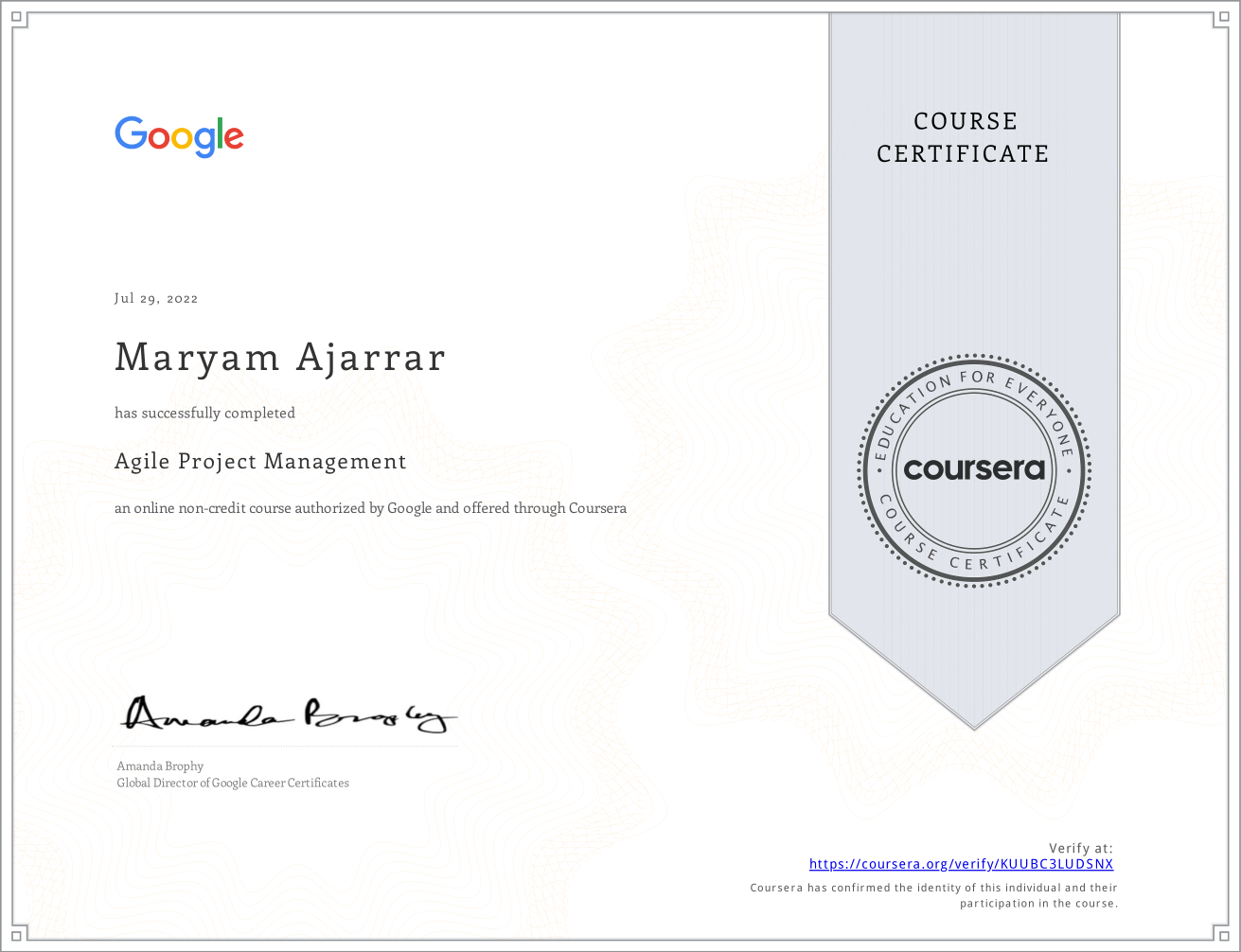
Link to the verified certificate on Coursera
Course 6 – Capstone: Applying Project Management in the Real World
In this final course of the program, I had the opportunity to apply all the knowledge and skills I learned in the previous courses. The capstone course was an exciting and practical experience that allowed me to “observe” a project manager in a real-world scenario (Sauce & Spoon project) and complete dozens of hands-on activities.
As I progressed through the course, I learned how to analyze project documents to identify project requirements and evaluate stakeholders. I also gained hands-on experience in creating a project charter and using it as a tool to align project scope and goals among stakeholders. Moreover, the course also included practical activities such as identifying tasks and milestones, documenting and prioritizing them in a project plan, and defining quality management standards.
One of the most valuable skills I gained from this course was the ability to effectively share qualitative data and demonstrate the impact of a project through effective reporting. I found this to be a crucial aspect of project management and was pleased to have the opportunity to practice and apply it in the course’s real-world scenario.
Overall, the capstone course served an excellent opportunity to consolidate and apply the project management knowledge and skills I acquired throughout the entire program. Through practical, hands-on activities and analysis of a real-world scenario, I was able to demonstrate my ability to manage projects successfully at an introductory level as a junior project manager.
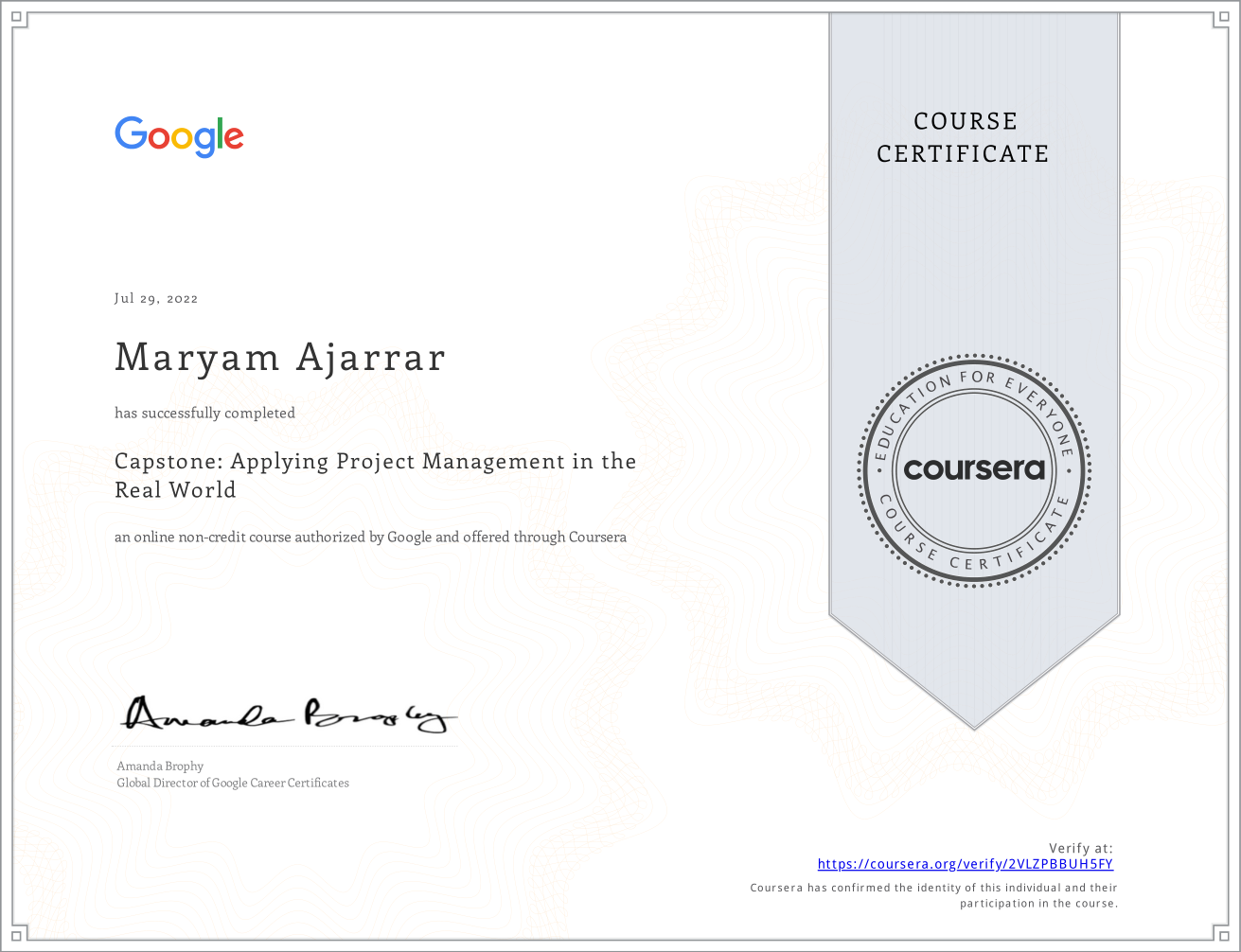
Link to the verified certificate on Coursera
What I liked about the program
While I have found the program to be challenging at times—yet manageable—especially since I have no prior experience in project management, I have appreciated the supportive learning environment provided by the program. The instructors are knowledgeable, and there are also discussion forums where I could connect with other learners who went through the same learning journey as I did.
One of the things I appreciated most about the program is its emphasis on practical, hands-on learning. Each course includes interactive lessons and assignments that use Google’s tools, which have been easy for me to use. This practical approach to learning has helped me better understand the concepts covered and prepared me for the capstone project that is part of the final course in the program.
The latter challenged me to put into practice the project management concepts and techniques I had acquired over the course of the certificate program. This approach to assessment allowed me to demonstrate my learning in a practical and meaningful way, and provided me with the confidence and skills necessary to apply project management skills in a real-world scenario. More importantly, the portfolio of project management artifacts I’ve developed throughout the program serves as tangible evidence of my skills and showcases my readiness to take on challenging projects in the field.
What I didn’t like about the program
The one thing I didn’t like about the program was the peer grading system for assignments. While I found peer grading to be a valuable learning opportunity, it did have its downsides. Unfortunately, not all of my peers took the grading process seriously. Some of them seemed to take pleasure in grading assignments unfairly, which was annoying. Besides, I often found myself waiting longer than expected for feedback, which slowed down my progress in the program. It was frustrating to put in a lot of effort into an assignment, only to receive a low grade due to someone’s negligence or lack of effort.
Even worse, there were times when I had to grade poorly done or plagiarized assignments, which was an unpleasing task to do. I understand that peer grading system is an essential component of the program, but I believe that it could be improved to ensure that all learners receive fair and timely feedback. Despite this issue, the program still provided a valuable learning experience as a whole.
The bottom line
If you’re looking to gain job-ready skills in project management and develop an understanding of what it’s like to be a project manager, the Google project management certificate program is a great choice. The program covers all aspects of the project lifecycle and provides a comprehensive overview of common project management approaches. The 6 courses are designed to prepare you for in-demand and entry-level positions in project management across a wide range of industries. You can complete the certificate in just 3-6 months, with no previous relevant experience required.
As someone who has completed the program intensively in 3 months, I highly recommend it. The hands-on approach to learning and emphasis on practical skills make it an enjoyable and valuable learning experience. The supportive learning environment and expert instructors also ensure that you have all the resources you need to succeed. Whether you’re looking to start a career in project management or simply want to gain a new set of skills, this program is an excellent investment of your time.
To sum up, the Google project management Certificate program was an incredible value for the amount of invaluable knowledge I gained. Despite the affordable price, the program covered all aspects of project management in great detail, providing me with a comprehensive understanding of the field. I was pleasantly surprised by the quality of instruction, course materials, and hands-on learning opportunities that the program offered. All things considered, I found the program to be an excellent investment in my career development.
Proof of successful completion of the program:
Featured image courtesy of Grow with Google.
Last updated: March 1st, 2023.
